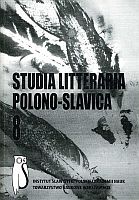Krytyka rozumu podzielonego. O derridiańskim konceptyzmie
Critique of Divided Reason
Author(s): Łukasz WróbelSubject(s): Literary Texts
Published by: Instytut Slawistyki Polskiej Akademii Nauk
Summary/Abstract: In this paper I analyze Jacques Derrida’s writings. My standpoint is following: so far the overall consequences of his writings for human sciences were omitted by his commentators. Packed with alliterations, antithesis, chiasms, congeries, epanalepsis, homonyms, oxymorons, paronomasia, periphrasis, specific comparisons, syllogisms (that are creating specific fields of cognition) or synecdoche, these texts are in fact a tryout to draw the dimensions of „new science.” Moreover, Derrida bases his writings on the idea of metaphorical chain (extended metaphor progressively developed through subsequent symbolic associations built up on the previous ones), woods of metaphors (density, concentration of metaphorical speech) and uses in his inquiries a 20th century form of the baroque conceit. Following the baroque theorists like Tesauro, le Moyne or Bouhours, Derrida uses metaphor as an instrument and a form of cognition (La Mythologie blanche) and takes the modes of presentation to the extreme (for instance in Glas). What is more, in Derrida’s case this is not merely some form of concors discordia but his gesture is much more serious. Rejecting a traditional linear form, Derrida builds up his specific metaphoric style to present his thesis and arguments and demolishes a clear Kantian system (with its three distinct spheres: cognitive [theoretical reason], practical [ethics] and esthetic), on which modern science has been built. Derrida’s conceptualism combines the three critiques into one amalgamate what effects in a necessity to create some new systems of presentation, adjusted to new instruments and forms of cognition. Derridian etymologies, metaphors, homonyms based on a spelling mistake (differance), as well as his style of writing combine both cognitive and ethical dimensions and – due to his style – also esthetical one. This is the main reason of difficulties in reading Derrida. He breaks the tradition of scientific formal mimetics and abandons the traditional scientific manner of presenting any thesis and arguments forcing his followers to do the same (it is impossible not to write in „Derrida’s style”). This traditional scientific formalism is replaced by conceptual imitation that affects the readers, the followers and the commentators (it is common to copy or follow conceptual solutions; distinct style is just one aspect of this tendency). Deconstruction not only made institutional divisions of faculties problematic (for instance, a relation between philosophy, literary theory and literary criticism), but it also critically analyzed all the theories, methodologies and notions used (notions of reference, fiction, representation, mimesis, mechanisms of constructing subjectivity, organizing and disorganizing of sense). Furthermore, it has restructured a number of important problems and claims coming from various branches of science. At the same time, trying to avoid crystallization, is has been changing strategies of analysis...
Journal: Studia Litteraria Polono-Slavica
- Issue Year: 2008
- Issue No: 8
- Page Range: 93-118
- Page Count: 26
- Language: Polish

